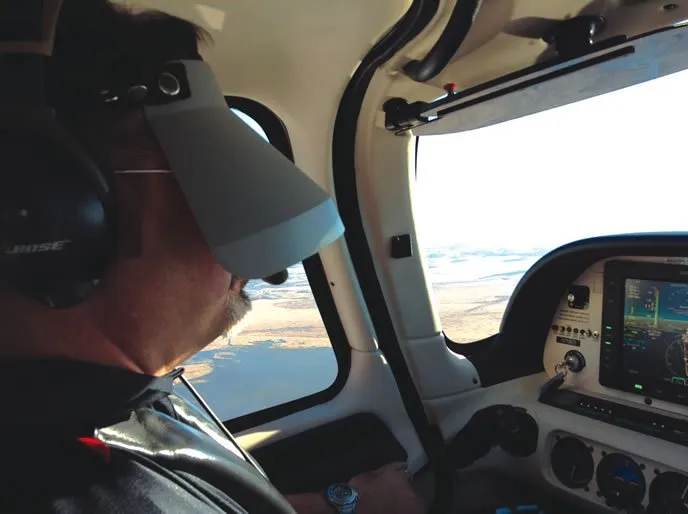Many of us feel that an IPC is as much fun as a visit to the dentist. We go through the checkup and if things are OK, we go on with our lives ’til the next appointment. Worse, for some the IPC is akin to a root canal—something to dread because they’ve neglected the preventive care. It’s the penalty for losing currency past the six-month window specified in 14 CFR 61.57.

In any case, IPCs don’t pique much excitement. They are an occasional formality for those who fly the system often, or a major chore for those who don’t. It doesn’t have to be that way. Rather than something to avoid, an IPC can improve your skills while you brush up on procedures you don’t use often. You can even go further and have a bit of fun.
Yeah, fun. In daily IFR flight, predictable and comfortable are good. The best response to “How was your flight?” is “Uneventfully successful.” We don’t want unusual or difficult. Actual equipment breakdowns or emergencies are thankfully rare, but you want to be on your game when they happen. Unfortunately, all that routine doesn’t keep you on your game for the abnormal situations.
Use the IPC to stretch your skills. Figure out what you’ve neglected and refresh those basics. Then tackle new things. This keeps you proficient while you continue to expand your IFR repertoir. As a bonus, you’ll never worry about staying current.
(In March we ran Frank Robinson’s “Proficiency in Pieces 2.5.” If you’re not ready for that formal process to maintain proficiency, start down that same road by following the advice here. —FB)
Back To Basics
Notwithstanding the upcoming migration to Airmen’s Certification Standards, the IPC currently takes its content from the Practical Test Standards. So in some ways it recreates a checkride. Take a look at the task list for things you haven’t done in months…or longer. When was the last time you had an honest-to-goodness VOR-A approach, going missed and flying the published hold, or a no-radar procedure turn or a hand-flying session rehearsing unusual-attitude recoveries? Can you perform these operations to the standards? (Recall that the standards look for overall competence, along with hard numbers such as maintaining altitude plus or minus 100 feet.)
Perhaps you stay current because you file for all your trips, you fly approaches (the local RNAV and ILS) regularly and you even remember to ask for the occasional hold. Legally, you never need an IPC. But while you’ve got the frequency, you don’t have the variety to stay proficient. You don’t want to go someplace new and dread getting a VOR/DME you’ve not flown in years.
Focus first on the tasks you’ve not done recently. Study the operation, know how it should work in your aircraft, then go practice with your instructor or safety pilot. Show up for your IPC confident you’ll exceed the testing standards.
Unusual attitude recoveries, for example, are something we hope never to do for real. But they are emergency maneuvers designed to be automatic responses to recover from a wake-turbulence upset, runaway autopilot or other anomalies. If you don’t regularly practice these anomalies, you lose the muscle memory and increase recognition-response time.
Or, say you’ve never really mastered partial panel approaches and thankfully, never had to fly one for real. Make that the focus of your refresher. Start with the classic vacuum pump breakdown, in a sim if possible, and get better at it. Perhaps your initial training was weak or your scan has become more of a stare. Work with your instructor during your IPC to overcome these shortcomings.
Remember, you can’t fail an IPC. You can make it a train-to-proficiency event. If you don’t initially meet the standards, you train until you do. Use the IPC to hone old skills and build new ones.
Try These At Home
Ever fly a circling approach to a short runway? Or flown an IAP without an airspeed indicator? If you aren’t comfortable in such situations, well, it’s time to get comfortable. These are all things that can and do happen and you want to be confident you can handle them. So, once you’ve covered the basics, start pushing the envelope.
Start by enhancing your newly refreshed unusual attitude skills. Most of us were trained via the textbook nose-high and nose-low recoveries appropriate to the aircraft or simulator we were using. The attitudes probably weren’t all that unusual—less than 45 degrees of bank and 15 degrees of pitch. But, actual upsets can be wild and crazy, so you’d do better to get more extreme.
While your instructor keeps an eye on things at a safe altitude, simulate a runaway trim stall on climbout. Take it to the actual power-on stall. This will take you to three unfamiliar places: the IMC stall itself, the excessive pitch angle and a recovery battle with extreme trim. (By the way, instructors: Don’t tell your victim about this in advance. It’ll be a surprise in an actual failure, so it should be a surprise in practice.)
The autopilot is also a great tool for simulating malfunctions or human-error upsets. These scenarios are more realistic and will take you to the corners of the flight envelope, yielding valuable experience and confidence.
Variety Is…
Partial panel approaches should go beyond the IPC vacuum failure. Any gauge can take a break. Pitot tubes swallow bugs. Static ports ice up. Digital displays or sensors can lock up. Many an aged turn coordinator has ground to a halt in flight. Oh, and don’t forget to review your systems so you understand how each instrument—mechanical or electronic—will behave.
Back at the airport, you should continue flying with the “malfunction.” Fly an approach, preferably a precision approach. Then try different landings after your approaches, including landing on an “icy” runway and even circling in gusty crosswinds. Finally, see how you can handle a last-second simulated runway incursion as you’re in the flare—or just after.
Each IPC should be different to keep fine-tuning all your skills. Consider completing an IPC every 6 months. If your insurance mandates periodic training, just wrap this into the mix. Be sure to work with a CFII who’s willing to conjure up a few interesting surprises and work at the edges of the envelope. You want to be challenged and evaluated to high standards. This will keep you proficient while adding to your repertoire of normal, abnormal and emergency procedures. Legal currency is just a bonus.
Fly to new airports, large and small, and especially those that offer interesting approaches. For example, Baraboo, Wisconsin’s airport has a VOR-A approach that at first glance looks like a straight-in to Runway 19—the final course lines right up. Take a closer look and you’ll see that the distance between the VOR and the runway doesn’t allow for a normal descent per 14 CFR 91.175. Only circling minimums will work. If you fly this approach half a year later in a different season, you’ll find that it presents a different situation each time, like a monstrous tailwind at the final approach fix.
You should draw up your own program with your instructor. Each normal and abnormal operation you’ve expanded on can apply to multiple types of approaches, aircraft, and weather conditions. The IPC thus becomes a template to use while applying a different theme or focus each time. There is a wealth of resources for new training opportunities readily available, from monthly NTSB reports to the scenarios and clinics presented by type clubs and pilot organizations.
The time it takes to schedule and plan a regular IPC using various scenarios isn’t much compared to the time you’d need to ready yourself for a full-blown refresher course because you got rusty at the nuts and bolts of instrument operations. Make it a regular part of your flying and you’ll find yourself a more skilled, confident and current pilot.





